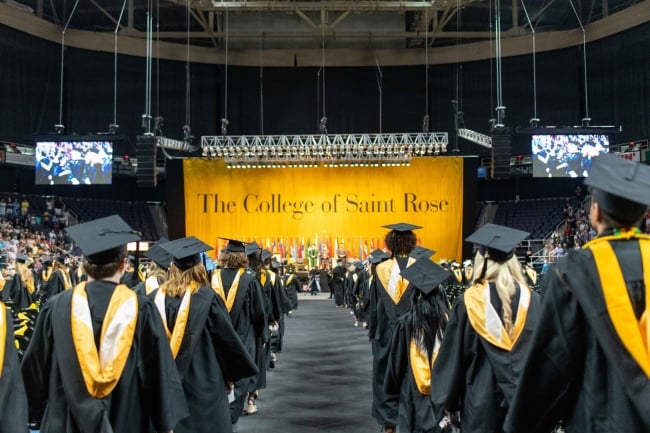You have /5 articles left.
Sign up for a free account or log in.

The College of Saint Rose will graduate its last class in May before shutting down.
The College of Saint Rose/Facebook
The future seemed bright for the College of Saint Rose at the dawn of the new millennium. Enrollment was climbing, new facilities were going up and generous donors kept opening their wallets.
Then, in the 2010s, things began to shift. Enrollment collapsed, leading to multiple rounds of job and program cuts. The Albany, N.Y., institution sold off assets and faced scrutiny from its accreditor, the Middle States Commission on Higher Education, over its shaky financial status.
Last week the College of Saint Rose announced that it would shut down.
“It is with a heavy heart that the board decided to close the college at the end of this academic year,” Board of Trustees chair Jeffrey D. Stone said in a news release issued Friday morning that noted operational challenges prompted by the COVID-19 pandemic and demographic shifts. “The board determined that the college does not have the financial resources to operate for the full 2024-2025 academic year and therefore cannot remain a standalone institution.”
The statement also noted that Saint Rose faced a projected $11.3 million deficit this year.
Now the former Catholic college is set to close in May, ending a 103-year run. It is at least the 13th nonprofit college to announce its closure this year.
Timeline of the Collapse
The College of Saint Rose was founded as a private women’s college in 1920 by the Sisters of St. Joseph of Carondelet, a Catholic order, but over the years it secularized and turned coed. For decades, the college was on firm footing, adding new buildings, students and funds to its endowment; between 1996 and 2012, the college spent $100 million on new facilities.
Visible cracks began to show in the 2010s as enrollment slipped and the college began to operate at a deficit regularly.
In fiscal year 2011, the College of Saint Rose posted a net income of nearly $5.7 million, followed by roughly $2.3 million in FY 2012, according to online financial records. The next year that figure fell to $852,701. It was the last time the college would generate income in successive years; through most of the rest of the decade, Saint Rose operated at a loss. In fact, since FY 2013, there were only two years when the college did not operate at a loss. Some years were particularly difficult; the college saw a loss of $4.7 million in FY 2016, $8.8 million in FY 2019 and $11 million in 2020.
That financial collapse seems tethered to plunging enrollment. Saint Rose’s student body shrank from more than 4,500 in fall 2013 to about 2,800 this fall, according to figures from the Department of Education’s Integrated Postsecondary Education Data System. (A recent college press release put that figure at 2,600 students.)
As it struggled with enrollment, Saint Rose sought to reduce its faculty numbers.
In 2015, college leadership announced plans to eliminate 40 staff jobs. The following year the college said that 23 faculty jobs and multiple academic programs would be axed, prompting condemnation from the American Association of University Professors over the process and a faculty no-confidence vote in then president Carolyn Stefanco, who joined Saint Rose in 2014.
In early 2017, faculty called for Stefanco to resign or be fired. While trustees initially expressed “unwavering support” for the president, that support soon crumbled. Multiple trustees resigned; one, Gregory Serio, accused the president of having “a secretive management style, closed-circle communication methods, obvious preoccupation with personal interests and apparent disdain for the board and its critical role in the governance of this institution,” according to excerpts from his resignation letter published in a local newspaper.
Stefanco stepped down in 2020. Faculty members welcomed the news, though trustees praised Stefanco for her leadership during a period of significant financial challenges for the college. Stone, the board chair, said at the time, “We are deeply grateful for her vision and leadership.”
Her exit was followed by another round of program cuts in late 2020.
Struggles continued following Stefanco’s departure, with enrollment slipping annually. In June MSCHE warned the college that its accreditation was “in jeopardy” due to its finances. By August the college had listed eight buildings for sale, with a total asking price of $3.6 million.
Late last month, The Albany Times-Union reported that Saint Rose had been seeking a multimillion-dollar emergency lifeline from state and local officials to remain open. But those dollars never materialized, and trustees voted Thursday to begin the shutdown.
The Big Picture
In a statement released Friday, president Marcia White said the college had explored various options, including partnerships, before deciding to cease operations.
“The board and my leadership team have been laser-focused on sustaining the institution. In recent years, the board eliminated high-cost academic programs, instituted faculty and staff layoffs, and reduced pension contributions, cut administrator salaries, re-financed the college’s debt, requested donors to unrestrict endowed funds, sold non-essential buildings, raised scholarship funds, and implemented a variety of new recruitment initiatives and strategies,” White’s statement said.
“No stone was left unturned,” White declared.
In an interview with Inside Higher Ed, White—an alumna and former trustee of Saint Rose before she became president—called the closure news “heartbreaking” and noted that the college hired consultants last summer to help with financial and enrollment challenges; they also had conversations with potential partner institutions.
The college went to state and local officials to seek bridge funding, she said, in order to keep Saint Rose open for the 2024–25 academic year while it continued to seek a partnership that would allow it to survive long term. Those efforts continued until Thursday’s vote to close the institution.
White declined to name any of the institutions Saint Rose had reached out to, saying she was unable to discuss potential merger partners due to confidentiality agreements.
The college is now working to finalize a teach-out plan and transfer agreements for students, she said.
WRGB, the local CBS affiliate, reported that the college had explored a number of proposals, including some type of agreement with the crosstown University at Albany, part of the State University of New York system. Though the University at Albany’s president, Havidán Rodríguez, did not address merger talks, he did release a statement acknowledging “the tenuous situation for many institutions of higher education across the country following the impacts of COVID-19 and the demographic shifts that we are confronting, especially in our region”—a nod to declining college-going rates in the Empire State.
With closure on the horizon, White said 29 college employees will be laid off in January.
Parallel Situations
In some ways, the Saint Rose closure bears similarities to the travails of another struggling private institution a thousand miles away: Birmingham-Southern College in Alabama. Facing the likelihood of closure due to years of financial issues brought on by major investments in new facilities (and a costly miscalculation of student financial aid), Birmingham-Southern officials also made an appeal to state and local officials for money, seeking a $30 million lifeline to stay afloat. But unlike Saint Rose, Birmingham-Southern has succeeded on the funding front, with city officials recently announcing they would extend a $5 million loan to help keep the college open.
That financial support comes after BSC was denied a loan from a program established last year to help distressed private colleges in the state. Though the bill to establish the program was written by a Birmingham-Southern graduate who invoked the name of his alma mater when stumping for the legislation, BSC’s loan application was denied by state treasurer Young Boozer III. The Legislature has since discussed rewriting the law to limit the state treasurer’s role in disbursing the funds. The $5 million local loan is expected to keep BSC open until the law is likely changed next year.
Saint Rose’s closure was preceded by similar announcements from other institutions this year, including Magdalen College, Lincoln Christian University, Alderson Broaddus University, Alliance University, Cabrini University, Cardinal Stritch University, Finlandia University, Hodges University, Holy Names University, Iowa Wesleyan University, Medaille University, Presentation College and various for-profits. Though it has not announced a closure, the King’s College in New York City has ceased its academic offerings and was stripped of accreditation earlier this year.




